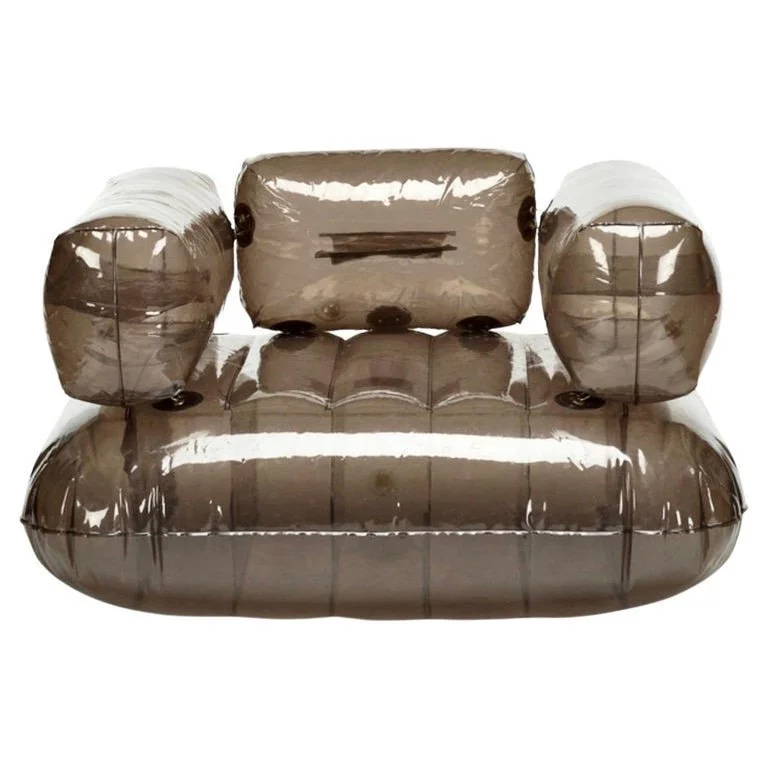Chester Lounge Chair Nguyen Manh Khanh, Aerospace Collection Quasar France, 1968
Chester Lounge Chair Nguyen Manh Khanh, Aerospace Collection Quasar France, 1968
Chester lounge chair Nguyen Manh Khanh, Aerospace Collection Quasar France 1968. PVC, chrome-plated steel. Rare, important piece.
Measures: 24 H × 42 W × 36 D in. Printed manufacturer's mark to reverse ‘Aerospace Quasar. Made in France’.
Hailing from Hanoi, Vietnam, Quasar Khanh was born Nguyen Manh Khanh in 1934. When he married his wife, French fashion designer Emmanuelle, in 1957, Khanh decided to adopt the pseudonym Quasar, referring to a star that shines from millions of light years away. The latter half of the sixties saw the designer and engineer’s career flourish; one of his most celebrated bodies of work made during this period, a range of inflatable furniture entitled “Aerospace”, continues to be in high demand today.
Khanh studied in Paris where he graduated with an engineering degree from Ecole Nationale des Ponts et Chaussées in 1959. While working for global consulting and engineering firm Coyne and Bellier, Khanh became involved in building the biggest multiple arch dam in the world at the time. Manicouagan 5, built in Canada, faced an issue with the toxicity of mercury and lead being used in the construction. As he sought an alternative for these problematic materials as well as the pressure they applied, the idea of using compressed air entered his mind. This would mark the beginning of a long and prolific chapter in his practice.
Khanh’s 1967 collection of inflatable furniture was born from this pragmatic research. The emblematic body of work became one of the milestones of furniture design and has been exhibited in museums around the world, including Centre Pompidou in Paris and NYC’s MoMA.
Despite a series of health issues, as recently as 2012, the voracious inventor was still developing and registering patents from his home in Ho Chi Minh City, Vietnam at the age of 78. An undisputed visionary, Khanh, who passed away in 2016, was often referred to as a “mad scientist” by his peers. His diverse practice spans a multitude of outputs, from plans for ships and planes, to architecture, cars, furniture design, and more. —Something Curated
Nguyen Manh Khanh, his real name, was born in Hanoi in 1934. He left Vietnam in 1949 and settled with his parents in France, more precisely in Paris. He studied engineering at the Ecole Nationale des Ponts et Chaussées, opted for the pseudonym Quasar Khanh and obtained his engineering degree in 1959. He worked for a number of well-known companies such as the Société Générale d’Entreprises and the engineering consultancy Coyne et Bellier. Ingenious and inventive, Quasar Khanh has worked on a wide variety of projects: boats, aviation, furniture, cars, fashion…
In 1968, he designed the Aerospace line of inflatable furniture as a tribute to the conquest of space. He was the first designer to have this original idea! Success came very quickly as the range was exhibited in 1969 at the Musée des Arts Décoratifs in Paris and at the Triennale in Milan. He is also the first inventor of a range of vinyl-covered foam furniture:“the velvet cube”. His creations can be seen at the Vitra Design Museum, the Musée des Arts Décoratifs in Paris, the Plasticarium in Brussels, and the Centre Georges Pompidou in Paris
Literature:
Quasar, sales catalogue, Paris, 1968, n.p.; 'Living in Heavenly Blue Blow-up Space in Paris’, Vogue, London, February 1969; Blow Up 233, 1986, pp. 67-71, for further reading; Nigel Whiteley, Pop Design: Modernism to Mod-Pop Theory and Design, 1952-72, London, 1987, p.198; Carey Zesiger, ‘A designer back in Vietnam', International Herald Tribune, 6 August 1996; Tom DiChristopher ‘Quasar Khanh: A Retrospective’ Asia Life HCMC, June 2010, pp. 56-60 for an article on the artist; Philippe Decelle, Diane Hennebert and Pierre Loze, L'Utopie du Tout Plastique 1960-1973, exh. cat., Fondation pour l'architecture, Brussels, 1994, p. 85;
Sean Topham, Where's my Space Age? The Rise and Fall of Futuristic Design, Munich, 2003, p. 99; Charlotte and Peter Fiell, eds., Domus Vol.VI 1965-1969, Cologne, 2006, p. 420 for an example in the Pneumatic Apartment; Alastair Gordon, Spaced Out: Crash Pads, Hippie Communes, Infinity Machines, and Other Radical Environments of the Psychedelic Sixties, New York, 2008, p. 105 for an example in the Pneumatic Apartment.

